The Sound of Success (Or the Silence of Frustration)
Hey, fellow gearheads and ice fanatics! Let’s talk about a subject that separates the weekend warriors from the true kings of the hardwater: your blades. This isn’t just about fishing; it’s about efficiency, endurance, and enjoying the thrill of the catch without the preceding struggle.
If you’ve ever been out on the ice, shivering slightly, ready to drill that perfect hole, and had your auger blades grind, squeal, and fight you the whole way down, you know the soul-crushing feeling of a dull edge. It’s like trying to cut concrete with a butter knife. It’s exhausting, it’s frustrating, and honestly, it cuts into your precious fishing time. Imagine the wasted minutes, the aching back, and the drain on your drill battery. That feeling of hitting the clutch on your power auger only to hear a “thud-thud-scrape” instead of the satisfying “whoosh” of clean ice shaving is a universal signal: you need a better edge.
We are talking about Ice Knife Sharpeners. Specifically, the tools designed to keep those expensive, mission-critical ice auger blades razor-sharp. Because let’s be real, a sharp blade is the difference between drilling 30 holes with ease and drilling three holes before calling it quits. A high-performance ice fishing setup demands high-performance maintenance. The investment in your electric or hand auger is wasted if you neglect the cutting surface.
Your auger blades are specialized pieces of equipment. They are not kitchen knives. They need precision, the right angle, and the right abrasive material. That’s where the right sharpener comes in—it’s the unsung hero of your ice fishing arsenal. These blades are often made from high-carbon steel, designed to withstand extremely low temperatures and the stresses of cutting through thick, sometimes dirty, ice. This unique steel and geometry mean they require a specialized approach to sharpening.
Forget shelling out big bucks for new blades every season, or risking a terrible factory sharpening job. We’re going DIY, saving money, and drilling faster than ever. We’re going to teach you how to maintain that razor-sharp, factory-perfect edge with five phenomenal tools available right now.
We’ve scoured the depths of Amazon to bring you the definitive, SEO-friendly guide to the top 5 ice knife sharpeners guaranteed to put a screaming edge back on your ice-cutting tools. We’re talking tungsten carbide precision, flexible abrasive belts, and the finest whetstone grit. Let’s dive into the gear that belongs on your sled this winter!
The Gearhead’s Guide to Edge Geometry 📐
Before we get into the top picks, let’s understand why sharpening an ice knife (or auger blade) is so different, and why you need a specialized tool. This isn’t just about being “sharp”; it’s about perfect geometry. Understanding your blade is the first step to mastering the perfect cut.
The Battle Against the Ice: Why Angles Matter
Ice auger blades are designed to attack the ice at a very specific, aggressive angle—often between 15 and 20 degrees per side. They typically have a steep primary bevel, the main grind that removes the bulk of the material, often combined with a tiny, super-fine secondary bevel (or micro-bevel) at the very tip of the edge. This micro-bevel is what gives the blade its final “bite” into the ice.
When you use a generic kitchen sharpener, you almost always change this critical angle. The wrong sharpener is often designed for a softer metal or a less aggressive angle. Once that factory angle is compromised, the blade stops “shaving” the ice and starts “mashing” it. That’s why your drill starts kicking back, the shavings look like powder instead of delicate ribbons, and you have to apply excessive downward pressure. The goal of sharpening is to maintain that original, precise, factory-set angle.
The Problem with Dullness and Efficiency
A dull blade also creates excessive heat and friction. For manual augers, this is simply exhausting. For power augers, especially the popular electric drill-based models, this is a major problem for battery life. More friction means the motor has to work much harder to rotate the auger head, drawing significantly more amperage from your battery. You’re not just saving your arms; you’re conserving the juice you need for the rest of the day. A sharp blade is a battery life extender.
Furthermore, a dull blade can lead to a condition called a “rolled edge,” where the very tip of the blade folds over due to impact or stress, forming a tiny, flat, or curled piece of metal that makes the blade completely ineffective. This is where the right sharpening material comes in to reset that edge.
Carbide vs. Whetstone: Know Your Abrasive
When shopping for an auger sharpener, you’ll encounter three main types of abrasive materials. Each serves a distinct purpose in the life cycle of your blade’s edge:
- Tungsten Carbide: Found in quick pull-through sharpeners. It’s extremely hard and fast, designed to reset a severely rolled or chipped edge by aggressively shaving the metal back into alignment. It removes a lot of material quickly, which is great for a fast repair in the field but should be used sparingly for regular maintenance to preserve the life of your blade. It’s the “emergency room” of sharpening.
- Ceramic/Diamond: Used for intermediate sharpening and honing. Diamond is often used for the initial, aggressive grinding of the steel, while ceramic is used to refine the edge after the carbide has done its job. These materials get the blade scary sharp without hogging away as much metal as pure carbide. They’re excellent for medium-level maintenance.
- Whetstone/Abrasive Belts: The most precise options. They come in varying grits and allow you to manually (whetstone) or mechanically (belt) control the exact angle, creating a custom, long-lasting, surgical edge. This method offers the best long-term care for the blade’s steel.
Understanding these differences is key to choosing the right tool for the job. Do you need a quick field fix, or a full weekend restoration?
The Top 5 Ice Knife Sharpeners on Amazon 🏆
Here are the heavy hitters, categorized by what they do best, that will ensure you cut clean, fast, and effortlessly through the hardest ice.
#1 AccuSharp AugerSharp (007C) – The Specialist Field Fix
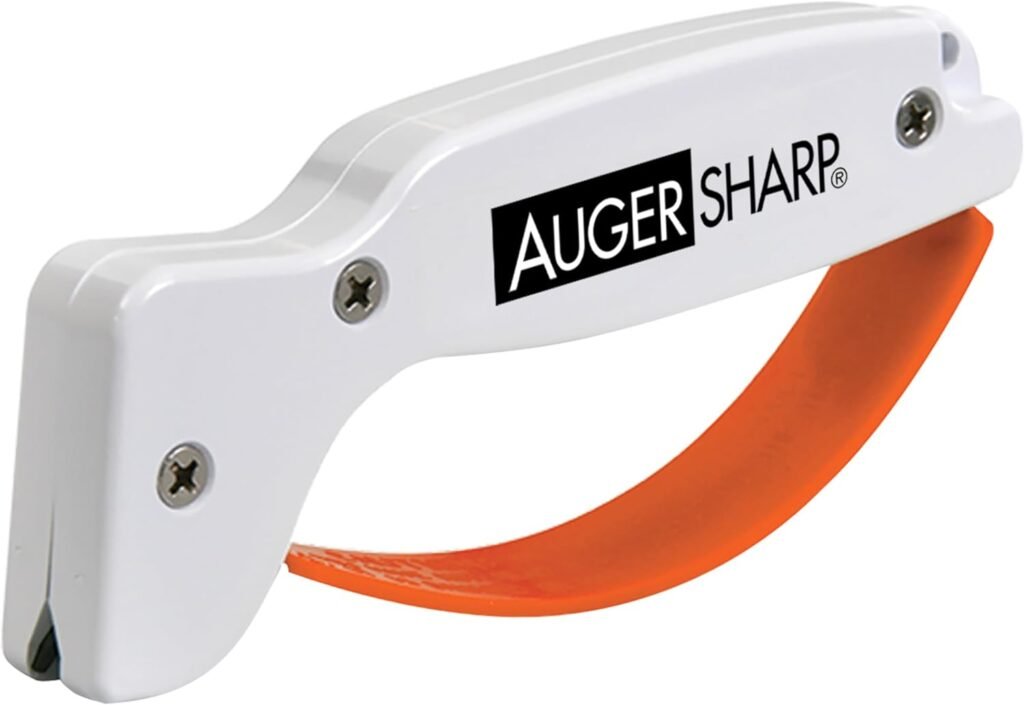
If you’re looking for a sharpener specifically designed, marketed, and proven for ice augers, the AccuSharp AugerSharp is the undisputed champion of convenience. It’s an ice fishing staple that has saved countless days on the lake.
Why We Love It: Dedicated Precision
This is not a general-purpose tool. The AugerSharp is built with one mission: to restore the specific aggressive cutting angle on standard ice auger blades (like Mora and some Eskimo styles). It features a reversible diamond-honed tungsten carbide blade, the absolute material of choice for biting into tough, hard steel and quickly removing a damaged burr. The diamond-honed carbide ensures the abrasive itself maintains its shape longer than a standard carbide.
The Quick Pull-Through Advantage
The beauty of the AugerSharp is its simplicity and speed. It’s a pull-through design, but unlike the cheap V-sharpeners you should never use on a fine kitchen knife, this one is calibrated for the aggressive cutting angle of an ice blade. It features a full-length, bright orange finger guard, which is a critical safety feature when working with such an aggressive edge. The bright color is also a huge bonus on the white snow and ice.
What Makes It a Top Pick?
- Ice-Specific Design: It’s bright orange, making it easy to spot on the white ice. It won’t rust, can be cleaned with soap and water, and the handle is ergonomic for gloved hands.
- Field Recovery: This is the tool you keep in your jacket pocket or tackle box. It can take a blade that snagged a rock or chewed dirt and get you back in the game with a few quick passes.
- The Bottom Line: Use this for touch-ups between trips or while on the ice. It’s the fastest, most effective way to revive a dulled edge and keep your arm/battery from burning out. For a quick fix that mimics the action of a professional sharpener, this is gold.
#2 Lansky Deluxe 5-Stone Sharpening System – The Angle Master 💎
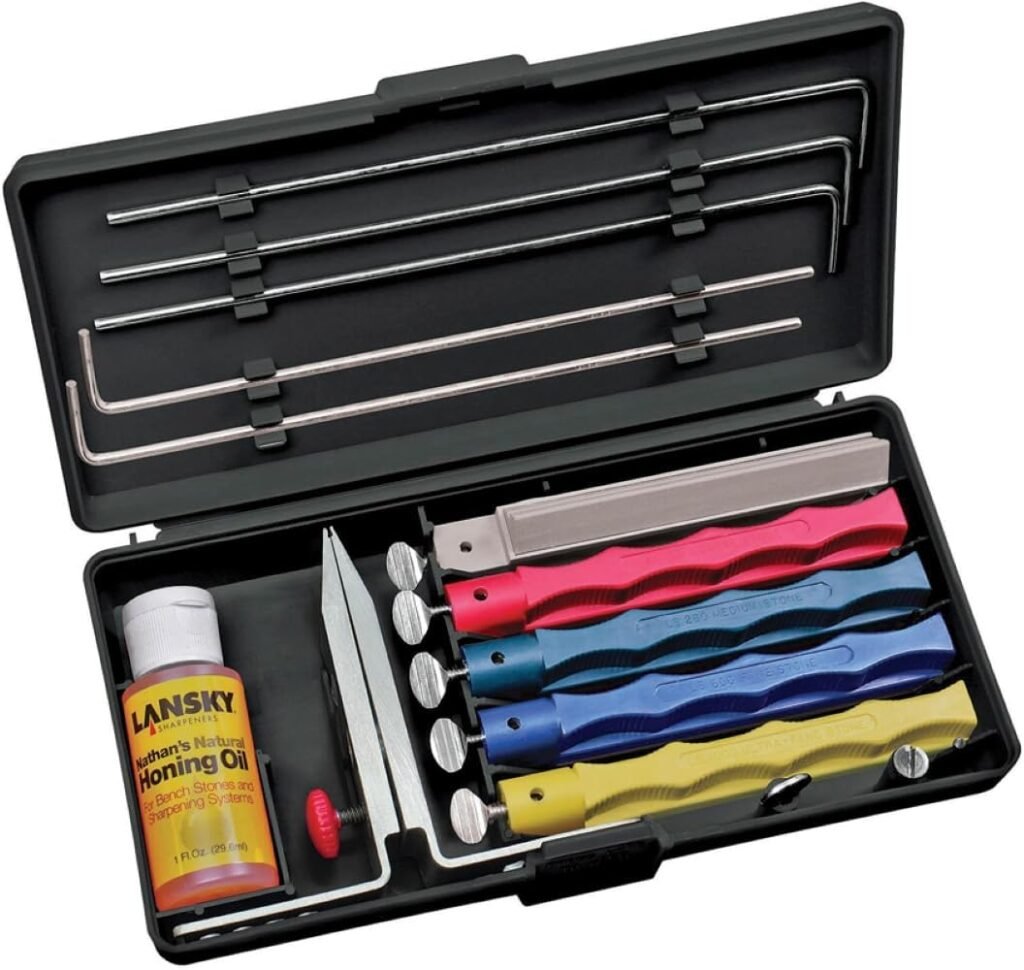
For the serious ice angler who insists on a professional, consistent edge angle—the kind of edge that lasts—a controlled-angle system like the Lansky Deluxe kit is a game-changer. This system is consistently recommended in ice fishing forums for one reason: it guarantees the same perfect angle every time, removing the guesswork entirely.
Why We Love It: Controlled Geometry
Ice blades rely on precise, consistent bevels. The Lansky system uses a multi-angle clamp to hold the blade stationary and a guided rod that attaches to the sharpening stone, ensuring you maintain the exact angle you set. You can meticulously match the factory angle of your Mora, Lazer, or Fin-Bore blades. This fixed-angle approach is essential for maintaining the integrity of curved blades.
Versatility and Range: The Five-Stone Edge
The Lansky Deluxe kit comes with five different stones, ranging from a coarse 70-grit (for repairing deep nicks and chips) all the way up to an ultra-fine 1000-grit ceramic stone for polishing the final edge. This range allows for full edge repair, restoration, and refinement—a true three-step sharpening process that the pros rely on. The five stone grades are typically: Coarse (120), Medium (280), Fine (600), Ultra-Fine (1000), and a special stone like a serrated or dedicated honing stone.
What Makes It a Top Pick?
- Precision Angle Control: This is the best way to replicate a true factory edge at home, which is crucial for high-performance Lazer blades that require a complex, consistent curve.
- Full Repair Capability: That coarse diamond stone can fix a truly abused blade, bringing it back from the brink of replacement.
- The Investment Edge: This system is an investment, but it’s the last manual sharpener you’ll ever need. It works for kitchen knives, hunting knives, and, most importantly, provides the fine control needed for specialized ice auger blades.
#3 Work Sharp Ken Onion Edition Knife and Tool Sharpener – The Electric Beast ⚡
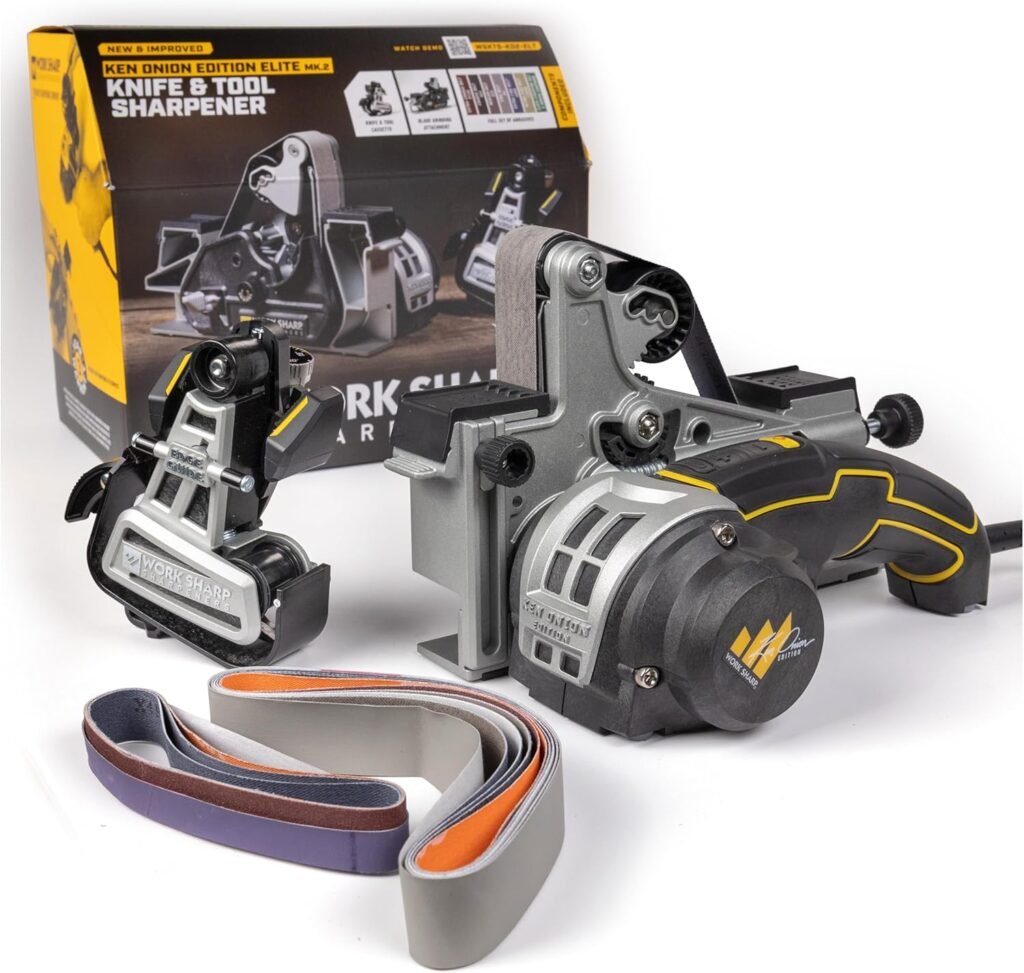
When speed, versatility, and the ability to re-profile a damaged edge are your priorities, you step up to the Work Sharp Ken Onion Edition. This electric belt grinder is a powerhouse that handles auger blades beautifully if you respect its power and precision.
Why We Love It: Flexible Abrasive Belts
Unlike a stationary wheel, the flexible abrasive belts of the Work Sharp conform to the curved edge of an auger blade better than any other electric tool. It operates at variable speeds and uses different grit belts (from P120 to 6000), much like a professional knife maker’s belt sander. This flexibility is key for adapting to the complex geometries of different blade styles.
Mastering the Convex Edge
Many high-end auger blades use a slight convex geometry for superior durability and ice shedding. This electric sharpener is perfectly suited to creating and maintaining that convex edge, which is nearly impossible to do by hand on a traditional whetstone. The adjustable angle guides further increase its precision.
- Safety Tip: When using a high-powered electric tool on auger blades, extreme care and practice are required. You must maintain control and keep the passes brief to avoid overheating the blade, which can ruin its temper (a process called “bluing” the steel). Always use the finer grit belts and light pressure.
What Makes It a Top Pick?
- Unmatched Speed: If you have multiple sets of blades or need to fix a seriously abused edge quickly, this machine saves hours of manual work.
- Versatile Design: It can sharpen virtually every tool in your garage, from garden shears to axes, making it a powerful year-round investment.
- The Power Factor: It’s the ultimate “reset” button for blades that seem beyond repair, providing the capability to change bevels if necessary.
#4 Smith’s PP1 Multi-Functional Sharpener – The Portable Lifesaver 🎣
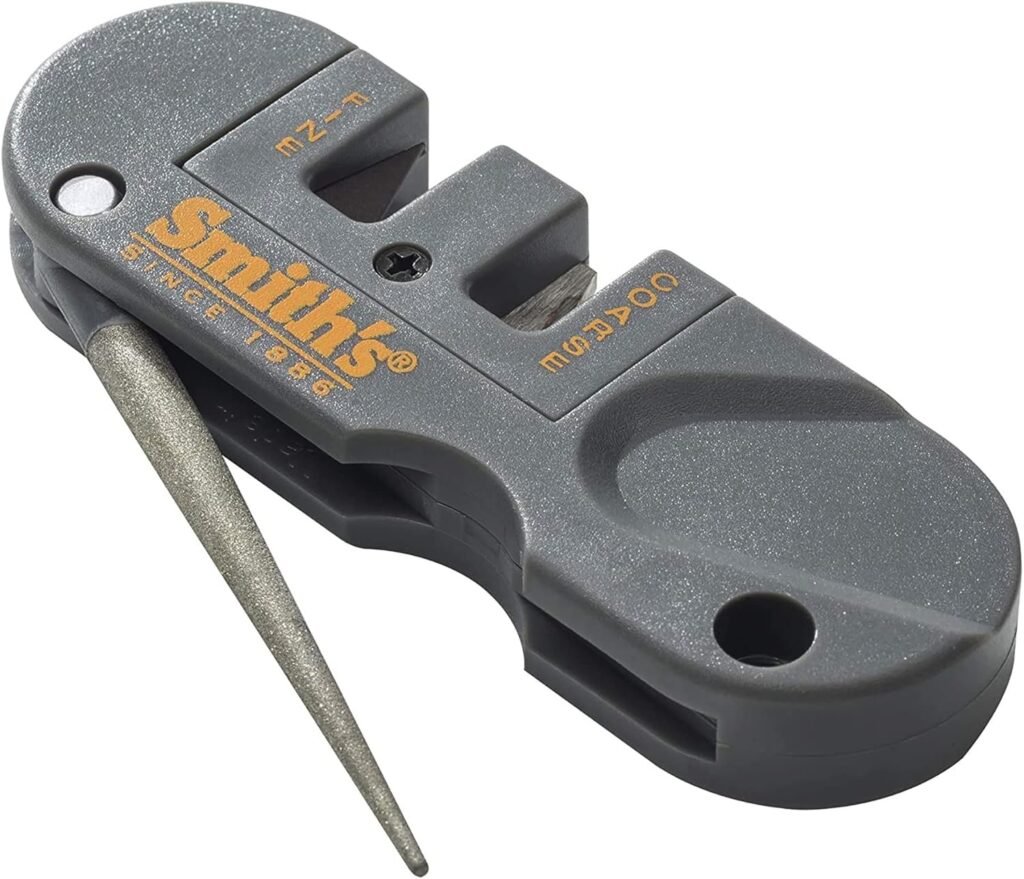
For the angler who needs something simple, inexpensive, and ultra-portable for mid-day touch-ups, the Smith’s PP1 is the go-to pocket-sized solution. It’s the essential insurance policy against an unexpected dulling.
Why We Love It: Pocket Power
The PP1 is tiny, light, and features two key sharpening tools in one compact unit: pre-set carbide blades for coarse sharpening and ceramic rods for final honing. While it’s primarily designed for fishing and hunting knives, the fixed angles (typically around 22 degrees) are surprisingly effective for quickly knocking a burr off a dull auger blade and performing a quick field hone.
Fast and Effective Touch-Ups
This sharpener is designed for speed on the bank, or in this case, on the ice. The quick pull-through design provides a serviceable edge when your main blades start to struggle three hours into a hot bite. It’s perfect for maintaining that “working edge” when you don’t have time to break out the full sharpening system. The small size makes it easily stored in a coat pocket or tackle box, ready for instant use.
What Makes It a Top Pick?
- Inexpensive and Durable: It’s cheap enough that you won’t cry if you drop it down a hole, but the carbide and ceramic materials are durable enough to survive years of harsh ice fishing conditions.
- Ergonomics: The oversized thumb grip and finger guard provide a secure grip, even when wearing gloves, making it safe and easy to use on the ice.
- The Backup Plan: Every ice fisherman needs one of these tucked away. It’s the emergency tire jack of the sharpening world—reliable and always there when you need it most.
#5 The High-Grit Whetstone Kit (1000/6000 Combo) – The Surgical Finisher 🔪
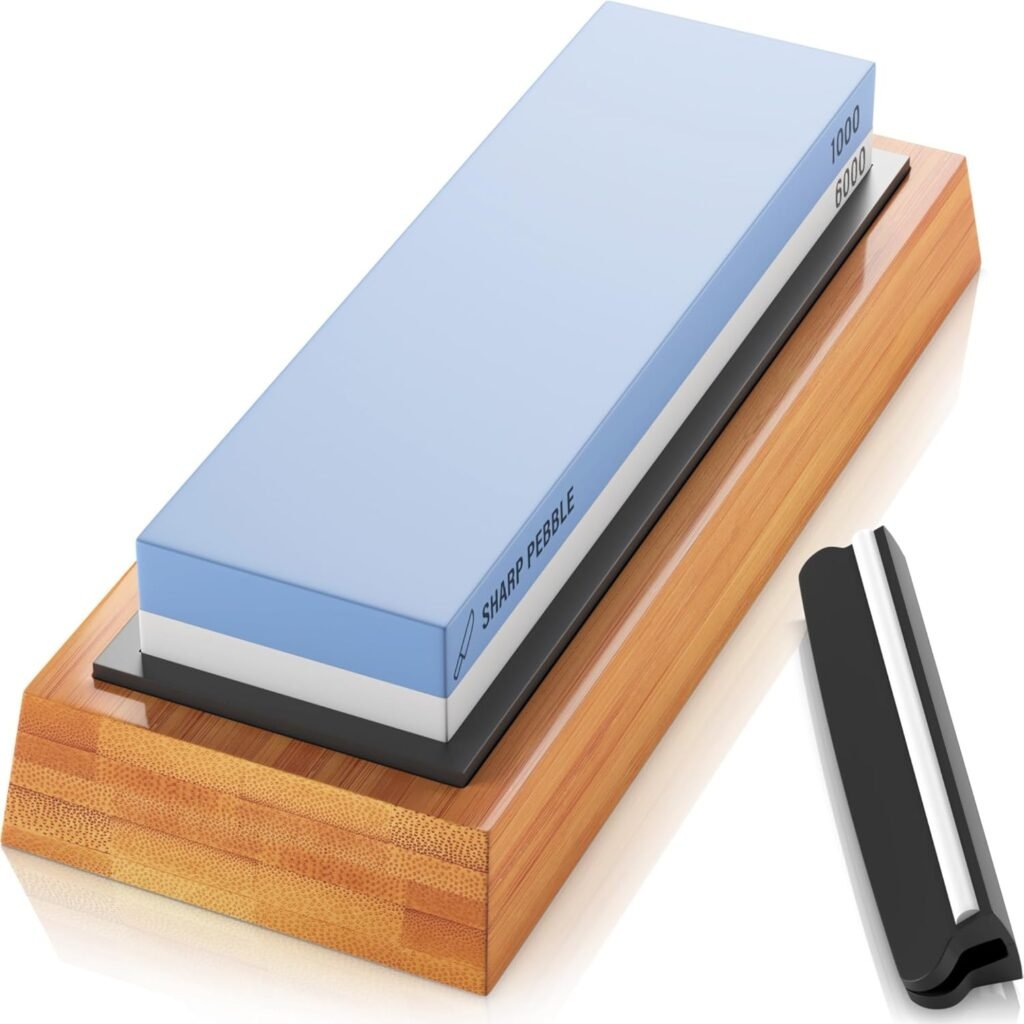
If you are a true enthusiast seeking the most refined, mirror-polished, shaving-sharp edge possible, you need a high-quality whetstone. We recommend a Japanese-style combination stone, usually featuring a 1000-grit side and a 6000-grit side. This method requires skill, but the results are unparalleled.
Why We Love It: The Ultimate Edge
Whetstones, also known as water stones, remove the least amount of metal, meaning they prolong the life of your expensive blades. They offer the absolute highest level of control and, when used correctly, produce an edge that cuts ice with zero friction. This is how high-end custom blades are finished, providing a super-smooth edge that resists dulling and corrosion.
The Process of Perfection: Two-Stage Sharpening
- 1000 Grit: Used for the primary sharpening and setting the main bevel. It removes fine imperfections and prepares the steel. This is the workhorse side.
- 6000 Grit: Used for final polishing and honing. This stage creates a near mirror-finish on the edge, which is what prevents the blade from catching and dragging. The smoother the edge, the faster you cut. This is the finishing side.
What Makes It a Top Pick?
- Blade Longevity: Minimal metal removal means your expensive auger blades last for years, potentially decades.
- Surgical Sharpness: The edge quality produced by a 6000-grit stone is unmatched by any other system on this list. It’s truly a “slice through butter” feeling that electric sharpeners struggle to achieve.
- The Zen of Sharpening: Whetstone sharpening is a skill, a craft, and a calming ritual for the dedicated gearhead. It’s the most hands-on, rewarding method for achieving mastery over your edge.
The MindGearMen Buyer’s Checklist 📋
Shopping for the perfect ice knife sharpener requires you to think less like a shopper and more like an engineer. Here are the crucial factors to consider before you click “Add to Cart” on Amazon.
1. Identify Your Blade Geometry (Lazer vs. Chipper)
The most common mistake ice anglers make is using a chipper sharpener on a Lazer blade, or vice versa. Your auger type is the single most important factor.
- Lazer/Mora: These are curved, sophisticated blades with a slight, aggressive pitch. They demand a sharpener that can conform to the curve (like the Work Sharp electric or a manual fixed-angle system like Lansky). Precision of the original angle is paramount. These blades shave, they don’t chip.
- Chipper/Flat: These blades are simpler, often a straight-edged plate. A high-quality flat stone or an AccuSharp AugerSharp designed for flat planes can work wonders. These blades chip the ice away, requiring a different bevel.
You must know your blade type before buying! Using the wrong sharpener on a Lazer blade can ruin it instantly by changing the cutting angle.
2. Manual vs. Electric: Speed vs. Control
This is the classic debate, and for auger blades, it matters immensely due to the hardness of the steel and the precise angle needed.
- Manual (Lansky, Whetstone): Offers ultimate control. Less chance of overheating the steel. Ideal for light touch-ups, maintenance, and perfectionists. Takes much longer to correct a deeply damaged blade. This is the safest option for blade longevity.
- Electric (Work Sharp): Fast and effective for major repair and re-profiling. Best for high-volume sharpening or dealing with blades that have hit rocks. Requires high skill and a light touch to avoid destroying the blade geometry or overheating the metal. This is the most powerful option.
For most people, a combination of a reliable, fast manual sharpener (AccuSharp AugerSharp or Smith’s PP1) for the ice and a higher-precision system (Lansky or Whetstone) for home maintenance is the ideal setup.
3. Consider Grit Progression and Abrasive Material
As we discussed, a truly sharp blade is achieved by a progression of grits, not a single one. Using too coarse a grit on a slightly dull blade is like using a sledgehammer when you need a jeweler’s tool—it removes too much material.
- Coarse (120-400 Grit): Use for removing deep chips, nicks, and aggressively correcting the bevel angle. This should be an optional step.
- Medium (600-1000 Grit): The primary sharpening stage. This is what you use for regular maintenance to re-establish the edge.
- Fine (3000-6000 Grit): The honing and polishing stage. This is what makes the blade cut effortlessly. Don’t skip this step! It significantly reduces friction.
Look for sharpeners that provide this progression, or buy complementary tools to cover the full spectrum of grits needed for true edge refinement. The Lansky and Whetstone systems excel here by providing multiple stones to perfectly execute the progression.
4. Safety First (It’s a Handheld Grinder!)
Auger blades are designed to cut through ice, meaning they are incredibly sharp and very dangerous to handle. Safety should never be an afterthought.
Your sharpener should have a non-slip grip, clear guides, or a secure clamping system (like the Lansky) to keep your fingers far away from the cutting edge. Look for finger guards and ergonomic handles.
This is especially true for electric systems like the Work Sharp. Treat these tools with extreme respect—they are designed to remove material quickly, and fingers are no exception. Always work in a well-lit, steady environment and consider wearing cut-resistant gloves.
5. The Return on Investment (ROI) and Longevity
The average set of quality replacement auger blades costs between $35 and $60, depending on the brand and type. They may last one or two full seasons if you’re lucky and don’t hit anything hard.
A high-quality sharpener, like the AccuSharp AugerSharp or the Lansky System, costs about the same as one set of replacement blades. The difference? The sharpener will last for years, saving you hundreds of dollars in blade replacements over a few seasons. Furthermore, a consistently sharp blade will prolong the life of your drill and motor.
The investment is a no-brainer. Sharpening is not an expense; it’s one of the best ROIs in ice fishing gear, leading to more fishing time and less frustration.
Stop Grinding, Start Cutting! 🧊
We’ve covered the entire landscape of ice knife sharpeners, from the quick-fix simplicity of the AccuSharp AugerSharp to the surgical precision of a high-grit Whetstone. Each of these five tools offers a reliable path to a razor-sharp edge, but they serve different purposes. Choosing the right one depends on your blade type, your skill level, and your preferred location for maintenance (on the ice or at home).
- For the quick and easy route on the ice, stick with the AccuSharp AugerSharp.
- For the ultimate at-home precision and full edge repair, invest in the Lansky Deluxe System.
- For sheer power and speed to repair heavily damaged blades, the Work Sharp Ken Onion is your answer.
The one thing they all have in common is that they will dramatically improve your time on the ice. No more sweat, no more struggle, just smooth, satisfying ribbons of ice spiraling up the auger shaft. That sound is music to an ice fisherman’s ears!
Don’t wait until the hardwater season is in full swing and your blades are chipped beyond saving. Getting your sharpening kit together now is the single best prep move you can make. The better you treat your gear, the better it treats you. A truly sharp auger is a joy to use.
Ready to drill holes like a pro and stop fighting the ice?
👉 Your Call to Action:
Click on the link for the top-rated AccuSharp AugerSharp right now and add it to your gear bag. It’s the essential tool every ice angler needs. Then, head over to our comments section at mindgearmen.com and let us know: What’s your preferred sharpening method—manual or electric—and why? We want to hear what gearmen like you are running! Let’s get sharp!


